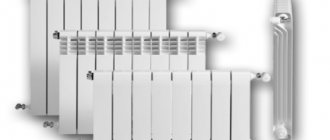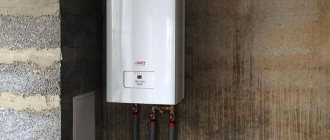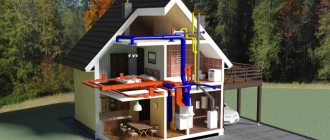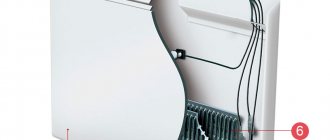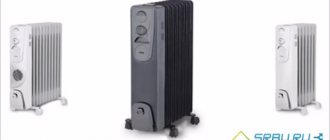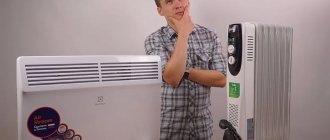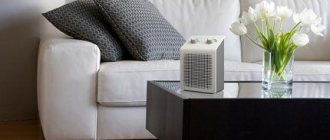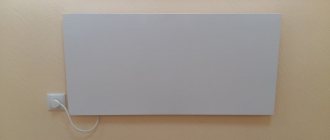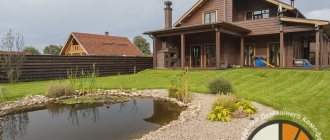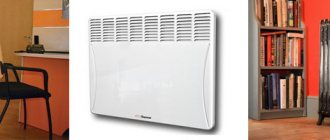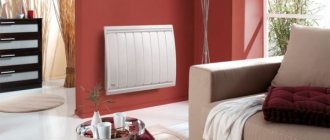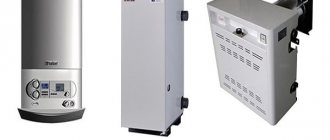Many people who have their own country house are interested in the question of how to heat it better and more correctly, especially if the energy source is electricity. In this case, there are only two options: electric convectors, which are directly connected to the electrical network using an outlet, or an electric boiler, which will heat the energy carrier and send it to the hydraulic radiator network. It is impossible to say for sure which of these two options will be better. At the same time, you need to consider options from all positions. Extreme views in such a situation are unacceptable. The fact that both options can be good in different situations is evidenced by the fact that at the moment, the same number of electric boilers and electric convectors are being produced, which means there is the same demand for them. If people use both options, then they have the right to exist.
Electric boiler and convector - what is the operating principle of heating devices
The boiler method of heating a home is considered one of the most common and popular heating schemes. The boiler running on wood, gas or coal fuel was considered the most problematic part of the system. Servicing such devices was too much of a hassle.
Therefore, with the advent of modern models of electric boilers, many owners of private houses, including wooden, log and aerated concrete buildings, gladly switched to using electric boilers. In addition, inexpensive and efficient electric convectors have become available, which are easier and more comfortable to operate than boilers.
Therefore, owners of small-sized housing, wooden baths and cottages are switching en masse from bottled gas, coal and firewood to electric heating. All that remains is to make a choice whether to use convectors or an electric boiler in a wooden house.
Pros and cons of convectors
Among the advantages are:
- ease of installation;
- small dimensions;
- ease of use;
- Possibility to place in any room (bathroom, electrical room);
- good performance;
- have an aesthetic design;
- they are reliable, environmentally friendly and safe.
Home owners prefer electric convectors, since they do not burn oxygen or dry out the air; there are models that can ionize the air.
There are few disadvantages:
- high energy costs;
- some models are more expensive.
What makes convectors convenient for heating residential premises?
In a simplified sense, an electric convector is a sheet metal housing with a lattice bottom and several rows of slots in the upper part of the metal box. A heating element is installed inside in the form of a package of plates, needle and wire heat exchangers. The air flow heated inside the convector rises and exits through the cracks, simultaneously sucking in a fresh portion of cold air.
Operating principle of the convector
The flow temperature is quite high, 100-120 °C, so heat is quickly transferred by convection upward to the ceiling. Part of the energy is transmitted through radiation from the walls of the convector; a temperature comfort zone is created at a distance of 50-60 cm from the body. Convectors are very convenient for country cottages and houses. In winter, when arriving at a frozen dacha, you can always settle down next to the heater and warm up without waiting for the heating system to thoroughly warm up the room.
Advantages of heating with electric convectors:
- A hot air stream rising upward effectively removes condensation from the windows and walls of a wooden house. For log houses and timber buildings, wet walls of a winter cottage have always been a problem. It is easy to dry a bathroom and even a bathhouse with a convector.
- All modern models of electric convectors contain built-in mechanical or electronic temperature control systems. Automation can be programmed or manually configured separately for each room and even a specific area of the room;
- Thanks to intense convection and increased air movement, natural supply and exhaust ventilation operates at its maximum potential.
Electric convectors also have disadvantages:
- firstly, to equip the heating system with convectors, you will need to make new wiring to each convector installation point;
- secondly, additional electric heaters, even when installed in a protective housing, remain a potential threat of fire in a wooden house or electric shock.
There is an opinion among ordinary consumers (reviews often confirm this) that convectors “burn through” the oxygen in the air, reduce the humidity of the atmosphere in the room, and saturate it with unpleasant odors of hot metal. All this applies to older models of heating convectors with open nichrome spirals. Metal heated to a high temperature burns not oxygen, but house dust. Because of this, the smell appears and the air humidity in the apartment or in a wooden house decreases.
Heating with convectors of a private house. The pros and cons of this heating method in the video.
What is attractive about a heating system based on an electric boiler?
The design of the device is an insulated metal flask, inside of which there is a heating element. Depending on the circuit of the electric boiler, the current flows either directly through the water or the heating element in the heating element, heating it to a temperature of 85-92 °C. The circulation pump of the electric boiler accelerates the hot coolant through the pipes and radiators in the same way as in any other water heating system.
Advantages of an electric boiler:
- the huge resource of the heating element is estimated at tens of years;
- the water heating zone in the electric boiler is completely insulated and grounded, so there is no risk of electric shock or boiling of the coolant due to excessive power;
- the entire heating part of the electric boiler is concentrated in one place, where there is no access for children, guests, or random people;
- there is no need to lay tens of meters of copper cable throughout the apartment, routing walls, wiring junction boxes or sockets.
Another huge advantage of an electric boiler is that you can use the old system of pipes and radiators left after disconnecting from centralized water heating.
The air temperature around the battery is lower, the heating intensity of the room is weaker, air flows move at a lower speed, and only a third of the energy is transferred by radiant heat. This means that when heating with an electric boiler, the windows in a frozen dacha thaw more slowly than in the case of a convector. But dust will not collect on curtains and curtains, and indoor plants will not dry out.
Compared to a convector, the rate at which an electric boiler warms up a room is lower, since there is inertia of heat transfer by water flow. On the other hand, if a wooden house is de-energized in winter due to an accident, the electric boiler will retain heat in the living quarters for another hour and a half. When heating with a convector, the room cools down in 30 - 40 minutes.
What is the difference between heating a private house with electric convectors?
It is better and more economical to use convectors than an electric boiler in the following cases:
- heated area of a private house is less than 80-90 m2;
- it is planned to purchase expensive models with precise electronic control and the ability to combine devices through a common thermostat or application;
- temporary residence in a house when the lower operating costs of an electric boiler do not pay for the high cost of purchasing and installing the entire system.
The most common misconception is that “convectors are more economical than an electric boiler, because during their operation, thermal energy is immediately transferred to the room (convector → air), while the thermal energy generated by an electric boiler goes through the cycle electric boiler → coolant → CO distribution → radiators → air.”
This is true, but it is worth taking into account the previously described factors: more stable temperature maintenance by the electric boiler, the presence of stepwise or even smooth power adjustment, the ability to work based on data from an external thermostat - all this has a much greater impact on efficiency, the difference is confirmed by practice and reviews from owners.
The exception is cases when budget electric boilers with stepwise power adjustment without external control and good convectors in the high price segment (from 8-9 thousand rubles) are compared.
Proper placement and connection of the convector to the electrical network of the country house.
What types of electric convectors are there?
To confidently navigate existing models of electric convectors, it is enough to pay attention to two basic characteristics of heaters. The first is the design of the convector body, the second is the installation method (floor and wall).
The first include more massive and powerful rooms that release heat into the atmosphere in all directions. They cannot be installed closer than 50 cm to wooden and plastic objects. They are connected to the electrical network with a separate cord, a heat-resistant Euro plug with a grounding terminal.
Wall convectors are manufactured in the form factor of a flat box. Heat release occurs on one side, so the device can be mounted on the wall.
Trench convector
The exceptions are log and wooden houses made of timber. The relatively low temperature of hot air is considered safe for wood. There is no risk of thermolysis or fire of wooden finishing, but under the influence of a dried air flow, the upper layers of a log or timber quickly lose moisture and dry out. As a result, microcracks form on the surface, and the crowns themselves can become deformed as the gaps and joints between the rows of timber increase.
To heat a wooden house, it is recommended to use floor convectors, and additionally coat the walls with a protective heat-resistant varnish.
To heat the air inside the convector, three main types of heating elements are used. The heating element for an electric convector is easy to distinguish from heaters for other devices by its characteristic shape. The design of the heating element is a horizontal block with a large number of needles, wire loops, and metal petals, with the help of which they increase the transfer of heat from the metal to the air flow.
In modern models of convectors, the heaters are made in the form of a monoblock made of aluminum, inside of which ceramic, oxide or graphite heaters are sealed. The service life of such heating elements is many times greater than that of wire models, but thanks to their specific design, electric heaters are resistant to shocks and falls on a hard surface. In case of burnout, they cannot be repaired.
Any convector model, regardless of its price or design, is equipped with a temperature controller. It could be:
- mechanical system based on a bimetallic plate. Low adjustment accuracy is compensated by durability and easy repairs;
- electronic circuit based on triacs and a rotary handle, characterized by reliability and high service life;
- programmable unit (it is often installed complete with an electronic control panel).
Convectors with mechanical adjustment can be connected to any electrical network, even if the voltage in the network changes during the day. Electric convectors with regulation of the second and third types are included in a stabilized network.
Best answers
Boss Heat:
The store correctly said that the ceiling height is 3m. Electric convectors are the cheapest option in terms of equipment and installation costs. And you will pay for electricity from the money you save on equipment. You can increase savings and comfort by connecting one convector through a room thermostat via air. The cheapest electric convectors are Chinese or jointly produced, cheap does not mean bad
Pay attention to the configuration of the heating element in the convector, if it is tubular with a screw band around the tube (DELSOT) - at night you will hear it clicking when cooling or heating. If you take more expensive convectors - Siemens, Atlantic, Nobo, then they have a built-in air thermostat and they don’t click
Installing convectors under windows, do not block them with curtains, do not dry things on them, do not block the air flow from above, i.e., observe fire safety. Infrared heaters can be installed where there are no people and high ceilings. It is not comfortable to be under it. Pay special attention to the safety of electrical wiring.
Pavel Melnikov:
I heat it, it’s -30 outside the window, sometimes I open the window in one room, I overdid it, but I’m quite satisfied.
prickly hedgehog:
Can you imagine how much you will pay for electricity????
&Ъ:
In such frosts, a lot of energy will be burned. Four kilowatts without turning off, Ten kilowatts per day. It’s possible to heat if you spend the same money as on firewood on electricity. But, in my opinion, it will be more expensive. Fan heaters provide good heating.
Sergunok:
depending on the permitted power (input machine) and the general condition of the electrical wiring
Pie with kittens!:
haven't encountered... On the contrary, I’m thinking why I rented the air conditioning for the winter - in a room below +30 only with an open balcony!!!! -they're drowning!!!!
Alexandra:
When it’s cold outside and the heating isn’t turned on, I use a convector. It’s very convenient, you turn it on at 22 degrees and that temperature stays constant. My relatives heat a house in the village. 1.5 kW at 18m.
Fool number one and a half:
Infrared are demanding in terms of dimensions - ceiling height, distance from the ceiling and walls. If the ceilings are low, they will be reachable, and the temperature is high, someone taking off a sweater could get burned. It is inconvenient to use them for such housing. Better convectors. The calculation indicated is applicable.
Konstantin Lozhkin:
Infrared in the house as the main heating is insanity, a constant headache is guaranteed. Convectors are good because they are inexpensive, easy to install and quite reliable. Regarding the selection of power, of course, they were correct, but with a ceiling height of no more than 2.8 meters and good thermal insulation. In general, I installed a Nobo in my house and divided it into 2 groups. Each group has its own thermostat. It’s a bit expensive to heat purely with electricity, so when it’s cold I still turn on the stove.
Yuri Dubov:
Dmitriy! If you can survive the winter as usual, try to survive it, plan house insulation work in the spring and summer, look at the technologies for gluing with foam plastic, etc., there are a lot of interesting things there, but only then do the heating. These works do not require special qualifications, but only then deal with heating. I would recommend a combined heating system
Pay attention to “beril” electric boilers, but first of all, eliminate as much heat loss as possible, the costs will pay off
Artyom Shlentov:
For anyone who is interested, I suggest that you familiarize yourself with the table of electricity consumption for ceiling film electric heaters:
Natalia:
I have been heating myself for 4 winters with convectors “noirot” France, I heat 94 square meters, at - 10-20 degrees I pay per month 2300-2900 if -25-40 degrees I cry 3500-5000 the temperature is set to +22 in the whole house, “nobo” is also a great manufacturer, all other convectors except “noirot”, “nobo” are not intended for constant heating, the main thing is that the house is well insulated and the wiring is good, I have a separate automatic circuit breaker for each convector, start with one convector, count how much electricity it consumes and make a decision, the devices are very convenient, I turned it on in the fall and turned it off in the spring, convenient!!!
Types of electric boilers and their features
Most models of electric boilers are produced in the form factor of a wall-mounted or floor-standing cabinet, inside which the parts and components necessary for the safe and stable operation of the heating system are assembled. The electric boiler itself is a seamless cylindrical container made of stainless steel, designed for high pressure of steam and hot water.
Depending on the model, water heating in an electric boiler can be carried out in three ways:
- by passing an electric current through a stream of water, two or three electrodes are installed inside the boiler;
- with the help of heating elements mounted in a steel flask, there can be several heating elements;
- induction of eddy currents onto the water flow using an additional electrical winding.
Electrode boilers are the easiest to use. The built-in protective magnesium electrode protects steel reinforcement from corrosion. The absence of additional windings and heating nichrome spirals guarantees high reliability of the design. The only negative is the accumulation of sludge in the heating system, so pipes and radiators must be flushed periodically.
An electric boiler with built-in heating elements provides precise control of the heating of the coolant. You can regulate the operation of the heating system manually by turning off the heating elements, and smoothly using a triac control unit.
Induction electric boilers have lower efficiency. Non-contact heating does not pollute the coolant, so the parameters of the heating system remain constant throughout the entire service life of the boiler equipment.
All types of electric boilers are equipped with automatic control of temperature and water pressure in the circuit. An expansion tank and a coolant level sensor are installed parallel to the heating unit in the heating system. The electric boiler will not start or will turn off at the sensor command in the following cases:
- water leaks or freezing in the heating system;
- clogging of the expansion tank;
- breakdown or jamming of the circulation pump;
- increased pressure in the electric boiler bulb.
All heating devices are installed and operated with circuit breakers, sometimes paired with an additional electricity consumption meter.
Description of heating elements of electric boilers
It is worth taking a closer look at the types of heaters used in electric boilers. Some values can significantly affect the choice of the appropriate model.
Tubular heaters are used in various devices: dishwashers and washing machines, convectors, as well as in electric heating boilers. The elements are completely immersed in the coolant and transfer heat to them. Among the advantages are the low cost and simple replacement of tens that have failed.
There are also some disadvantages of such heaters, for example, if the element is not completely immersed in the coolant, it quickly burns out. Scale forms on the heating elements, which somewhat slows down the heat exchange.
The induction type is quite expensive (both the equipment itself and its components), but this is compensated by the increased efficiency of the device. Heating is carried out due to the influence of a magnetic field (similar to induction electric stoves) on the coolant.
The design is very durable, the internal mechanisms do not wear out, with the exception of the control unit. If you plan to use the heating device for a long time, for example, permanent residence in a country house, then this type of system will be optimal.
Electrode boilers are particular about the composition of the coolant; the water should not be distilled, but contain salt. Moreover, the content rate is calculated after measuring the current. Here you will have to carefully study the instructions and determine the optimal composition of the water.
Principles of constructing a heating system using convectors and electric boilers
The decision about which heating method to choose is made based on basic criteria:
- the cost of the electric boiler or convector itself, estimates for refurbishment or initial installation of the heating system in the house/apartment;
- expected level of comfort and savings on electricity bills;
- the ability to use old infrastructure in the house - wiring, pipes, heating radiators.
The principles of planning a heating system using convectors and electric boilers are in many ways similar, there are only features associated with balancing the load across different rooms.
Features of installation of an in-floor convector
Border Rule 4 and 6
In order to decide what is the best way to heat a house, it will be very important to know the size of the house, or more precisely, the number of heating devices needed around the entire perimeter of the house. Experts were able to establish fairly clear boundaries. If the house is very small and only needs 4 heating devices, then there is no point in installing an electric boiler and radiator network. In such a house it will be much easier and simpler to install electric convectors. If the house is large enough and already needs 6 heating devices, then experts definitely recommend purchasing an electric boiler. A rather complicated situation arises if 5 heating devices are enough for your home. Indeed, in this case, you can choose both options for yourself.
Features of using an electric boiler
The average power of an electric boiler is selected at the rate of 100 W/h for each square of housing area plus 10% reserve. For heating systems based on electrode and heating element models of electric boilers, it is recommended to increase the reservation to 15%; for induction models of electric boilers, the reservation need not be made.
While special coolants based on ethylene glycol are widely used in gas boilers, they are not used for electric boilers. In electrode and induction models they are useless; in designs with heating elements, such a coolant degrades, decomposition products clog heating radiators and are deposited on tubular heating elements.
Experts recommend pouring distilled water with additives into the heating circuit and changing it before the start of the season.
The second requirement relates to the use of a boiler; a 200 liter insulated barrel will help save on electricity, especially if the house has a meter with a night tariff. During the day, the temperature in the rooms can be maintained by a heat accumulator, and in the evening you can start an electric boiler in the heating system.
The third requirement relates to proper load balancing. To coordinate hydraulic resistance and heat transfer, the heating pipes are divided into two parallel circuits. The first includes a living room and bedroom, the second - a kitchen, bathroom and toilet. The output from the circulation pump of the electric boiler is fed to a tee, from which the pipes diverge into two circuits. You just need to adjust the water flow through each heating line using a tap. If the house has two or three floors, then it is best to install several low-power electric boilers for each heating tier.
Principle of installation of convectors
Installing electric convectors in a house is easier than installing boilers. First, you need to determine where to install the convector in each room. For living quarters and kitchens, you can use models with protection level IP21, for bathrooms and toilets - IP24.
Secondly, for each convector you will need to lay your own cable with ground. We put the wiring in a heat-resistant channel and cover it with a plinth. In addition, each convector must have its own socket for a Euro plug with ground and a bag. The wire cross-section is selected according to the permissible constant load.
We collect all the wiring on a distribution panel with circuit breakers for each branch. Here you can install a programmable automatic machine that controls the operation of the convectors.
Difficulties in installing and using electric convectors
- Increased total power of electric convectors. Due to the fact that the power is selected for each individual room, there is always a loss of approximately 2-4 kilowatts. When all the convectors turn on at full power, and other electrical appliances are working in the house, this can lead to the breakout of the input circuit breaker. And the only way to combat this is by turning off the convectors in individual rooms manually, which is too troublesome.
- Electrical network. Due to the fact that the convector is a powerful electrical device, moreover, it works non-stop for at least 5 hours, it is necessary to install a separate cable for it. That is, you cannot plug the electric convector into any outlet that is in the house.
- Great difficulties for controlling convectors remotely. It is quite possible to do this, but for this it will be necessary to combine all the devices into one network, and then connect them to some executive device that will receive commands from you. This will require additional cash costs.
It turns out that buying an electric boiler and correctly installing electric convectors will cost you about the same amount. The installation cost of an electric boiler will be slightly higher, but it will pay for itself in the first year of its use.
Electric convectors for heating systems
Convectors are electric batteries in which air is heated naturally by passing through a heating element. It is enough to mount such a battery on the wall and plug it into a power outlet.
The convector control system is located directly on its body. And the air heating elements are hidden inside. First, the air in the immediate vicinity of the convector is heated, and then the rest. The warm one rises up, the cold one goes down and enters the convector. The buttons on electric convectors will allow you to set the desired temperature or set the battery operating mode. For example, “anti-freeze”.
According to the principle of control organization, convectors are divided into mechanical and electronic. The first ones have a pair of “wheels” on the body, by turning which you can “increase” or “decrease” the temperature. And the latter allow you to control the heating level down to 1-2 degrees.
There is a prejudice that heating with convectors is too expensive. But in reality it turns out that with the same square footage, electric heaters are 5-10% more economical.
Among other advantages of electric convectors, we note:
- Extremely simple installation. No pipes or wires. You simply attach the electric battery to the wall and connect it to the network. If necessary, you can remove the convector without disturbing the appearance of the room.
- There is no chance of a pipe with water or a heating element bursting, since convectors simply do not have them.
- Each convector can be adjusted to its own temperature regime. The bedroom can be made warmer. And the living room is a little cooler.
- The back wall of such a battery hardly heats up. All openings for air exchange are located at the front. You can mount the convector very close to the wall without fear of fire.
- Electric convectors are suitable even for children's rooms. The battery heats up, but does not burn when touched.
- Convectors are safe for the environment and health. They do not oxidize the air and do not emit harmful impurities.
Of the minuses:
- Electricity consumption will become the main cost item for servicing the convector.
- The time it takes to completely warm up a room depends on the area. To help the room heat up faster, close the door.
However, despite all this, electric convectors are breaking records of popularity among owners of country cottages and houses.
What is an electric boiler
An electric boiler is a heating device; its operating principle is to convert electrical energy into heat. The heating element acts on the flowing coolant circulating through the pipes of the heating system. Simply put, the heaters come into contact with water (or other chemical liquid) that moves through the pipeline, heating it. Radiators, in turn, warm the air.
Electric boilers are distinguished according to several criteria. By type of installation, devices are divided into:
- wall;
- floor
By type of heating elements:
- shadow;
- electrode;
- induction
Induction electric boiler
Models also differ in power (energy consumption) and functionality. The most affordable and simple boilers contain a heater and starting equipment, medium-functional ones are equipped with temperature control and monitoring units, and the most “top-end” ones are controlled remotely.
Note! Models with shades can have a dual-circuit system, which will provide the house not only with heat, but also with hot water.
The coolant is distilled or salt water, and antifreeze can be poured into induction boilers. In both cases, the cost of the liquid is quite low.
Comparative table of the cost of organizing heating
| House area, m 2 | Heating method | Manufacturer and model | Total cost, rub. | Price of 1 kW of thermal power, rub. |
| 60 | Electric convectors | Ballu BEC/EZMR-2000 (3 pcs.) | 3 000*3 = 9 000 | 1 500 |
| Electric convectors | REDMOND SkyHeat C4519S (3 pcs.): el. control, connection and programming via app | 9 600*3 = 28 800 | 4 800 | |
| Electric boiler and radiators | Protherm Skat 6 KR 13 + Rifar Base 500 x6 (4 pcs.) + harness | 32 000 + 4 200*4 + 5 000 = 53 800 | 8 966,6 | |
| 100 | Electric convectors | Ballu BEC/EZMR-2000 (6 pcs.) | 3 000*6 = 18 000 | 1 800 |
| Electric boiler and radiators | Protherm Skat 12 KR 13 + Rifar Base 500 x6 (9 pcs.) + harness | 35 000 + 4 200*9 + 6 000 = 78 800 | 7 880 | |
| 150 | Electric convectors | Noirot CNX-4 1500 (10 pcs.) | 6 300*10 = 63 000 | 4 200 |
| Electric boiler and radiators | Vaillant eloBLOCK VE 18 Rifar Base 500 x6 (13 pcs.) | 39 000 + 4 200*13 + 9 000 = 102 600 | 6 840 |
As you can see from the table, the larger the area of the house, the higher the cost of each kW of thermal energy obtained when heating with convectors and the lower when heating with an electric boiler. At the same time, the advantages and efficiency of an electric boiler are obvious.
BoilersHeatersElectric boilers
